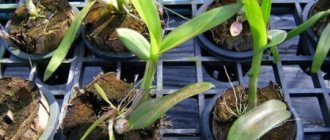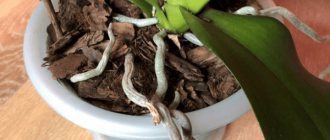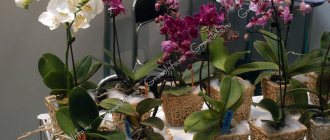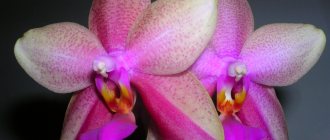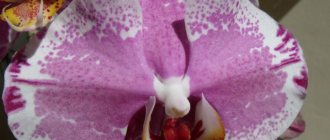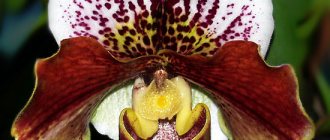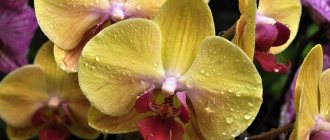So what's the difference?
Phalaenopsis (lat. Phalaenopsis) belongs to a genus of epiphytic plants from Southeast Asia. In nature, it lives in humid plains and mountain forests. This tropical plant got its name thanks to the director of the botanical garden, Karl Blume, who confused it with a butterfly. The word “Phalaenopsis” is translated from Greek as “Moth-like” .
These flowers are very beautiful and dearly loved by orchid fans. Phalaenopsis belongs to the orchid family, but they themselves represent a separate genus of plants. They are on a par with such genera of orchids as Vanda, Dendrobium, Cymbidium and others.
Thus, to the question whether this plant can be called an orchid, there is a completely clear answer: yes, you can, there will be no mistake. However, a more accurate definition would be the genus name.
The words “orchid” and “phalaenopsis” can be synonymous from a biological point of view: the genus has all the features of the orchid family. In other words, all phalaenopsis orchids are orchids, but not all phalaenopsis orchids are phalaenopsis.
What distinguishes phalaenopsis from other orchids is the following::
- Unpretentiousness. The plant does not require special attention and will be a good option for beginning gardeners.
- Moist air tolerance.
- There is no need for temperature changes during breeding.
- There is no need for dense and heavy soil. For Phalaenopsis, the soil serves as a support, nothing more.
Reproduction methods
Peduncle
The best time is the beginning of spring. If during this period the phalaenopsis released a new peduncle, then, without waiting for the buds to appear, cut the shoot to the first bud. Then place the plant in a well-lit window. An orchid may react to cutting off a peduncle by the appearance of a brown coating. be afraid! After a week or two it will disappear on its own. And after three months, a new plant will appear on the cut peduncle.
By cuttings
To do this, carefully remove the orchid from the pot, untangle the roots and use a sharp, disinfected blade to carefully divide the plant between the tubers. Then sprinkle the sections with crushed coal and let them dry for several hours, after which they are planted in pots.
This video shows how best to propagate phalaenopsis by cuttings:
Children
They appear on mature healthy plants between the peduncles. Separate only those shoots that have already formed their own aerial roots. They can be planted immediately in a separate pot. It happens that phalaenopsis shoots begin to bloom while still remaining on the mother plant. In this case, wait until the end of flowering and only then send the young plant to its own “house”.
How to get a baby orchid is shown in this video:
How does the appearance of phalaenopsis differ from other orchids?
The orchid is recognizable by its small or large leaves of light green color. They are generally hard, long and pointed. Phalaenopsis has semicircular leaves, collected in dense, beautiful rosettes. Its powerful grey-green roots extend beyond the pot.
Phalaenopsis leaves:
Phalaenopsis flowers:
Phalaenopsis roots:
General view of phalaenopsis:
Unlike most other orchids, phalaenopsis can bloom repeatedly. Of course, the most recognizable part of the plant is its beautiful flowers, which look like butterflies .
Features of care
Caring for this exotic plant is not particularly difficult. Certain rules will help you succeed.
It is recommended to keep the plant in a plastic or transparent pot, not ceramic . This is due to the unusual structure of the root system of phalaenopsis, for which maintaining soil moisture is extremely important.
The optimal temperature is 20-25 degrees in summer, not lower than 18 degrees in winter.
Attention! Unlike other orchids, phalaenopsis does not like temperature changes of more than 5-10 degrees.
Try to maintain humidity in the room where phalaenopsis is kept - not lower than 40%. If the air is dry, it is recommended to spray the plants at least twice a week, avoiding moisture getting into the leaf axils.
Phalaenopsis should not be watered too often.:
- in hot weather - every 2-3 days;
- in spring and autumn - once a week;
- in winter - once every two weeks.
To feed phalaenopsis you will need a special fertilizer for orchids or a complex mineral fertilizer (once every 10-12 days). Under no circumstances should fertilizer be poured onto dry roots , only into a wet substrate.
It is very important to choose the right place for phalaenopsis! Unlike other orchids, phalaenopsis love good light. The duration of daylight should be at least twelve hours - in winter, backlighting will be required. It is necessary to occasionally rotate the plant 180 degrees to avoid curvature of the stem. It is not recommended to turn phalaenopsis over while buds are forming.
It is recommended to replant phalaenopsis once a year after flowering. The plant does not tolerate prolonged flooding; garden or forest soil is not suitable for it!
When selecting soil, keep in mind that the substrate must have the following qualities :
- ease;
- looseness;
- breathability.
The mixture may consist of moss, pieces of plant bark, and charcoal.
Characteristics of subvarieties and photos with names
The genus includes approximately 70 species of phalaenopsis, and there are several times more hybrid forms . In the photo you can see what home flowers look like. The most popular for growing at home are:
Amabilis
Phalaenopsis Amabilis (fariyatny) is the most suitable for crossing, the progenitor of many orchids.
Schiller
It blooms over and over again and can do so for a long period.
Pink
A miniature species, phalaenopsis flowers reach 3 cm in diameter .
Horse
Blooms all year round, especially abundantly in spring and autumn.
Giant
The leaves can grow up to a meter in length. The orchid is loved by breeders and biologists and is suitable for breeding new varieties .
Staghorn
Yellow-golden color with brown specks. The peduncle has a comb-like outgrowth.
Stewart
It has a branching peduncle up to 80 cm long.
Luddemann
The flowers are purple-pink and open one by one.
Sandera
A very beautiful and rare variety with long drooping peduncles , which can bear up to 50 flowers.
Ambuanian
Grows in the shade, blooms in the summer months, produces several flower stalks at the same time.
Parisha
Another miniature variety: peduncle – 14 cm, leaves – 18 cm, flowers – 2 cm. It has a pleasant aroma.
Hieroglyphic
Lemon-yellow strokes are drawn on the white background of the petals . The flowers smell delicious.
Philadelphia
Hybrid of Stewart and Schiller varieties. The flowers are small, purple-pink, with a marble pattern on the leaves.
conclusions
Phalaenopsis belongs to the orchid family, but still differs from them in a number of ways. One of them is that in terms of its content, phalaenopsis is less demanding than other orchids . Adhere to the following rules:
- Water the flower evenly and regularly, avoiding overwatering.
- Monitor the humidity in the room.
- Maintain daylight hours, avoiding direct sunlight.
- Maintain an optimal temperature of 20-25 degrees, do not overcool the plant.
- Feed the plant moderately.
If you have long wanted to have an orchid, but were stopped by the difficulty of maintaining this plant, let phalaenopsis decorate your windowsill! If you follow simple rules, the plant will delight you with its wonderful appearance all year round.
Diseases and pests
Most often, the orchid is affected by non-infectious diseases . Exposure to sunlight causes burns on the leaves. Yellow spots appear if the flower is in a cold place or is poorly lit. Unreasonable watering leads to plant rotting. If an orchid has dropped its leaves, it means that the flower has been standing for a long time in a draft or under a stream of air from an air conditioner.
Viral diseases that occur in orchids:
- anthracnose;
- powdery mildew;
- rust;
- black fungus;
- rot.
Treatment is carried out by spraying with Ritomil, Mikasan, Skor . You can wash the plant in a solution of foundation or vitriol.
Pests:
- aphid;
- scale insect;
- worm.
First, the infected plant is washed under a warm shower (many pests die at temperatures above 40 degrees), then the pests are selected by hand and the orchid is treated with a 0.3% foundationazol, 0.2% benlate composition.
Several procedures are carried out with an interval of 2 weeks.
Some folk remedies help well: a solution of green soap, brewed onion and garlic peels.
We discussed in more detail issues related to diseases and pests of phalaenopsis, as well as ways to combat them, in this material.

